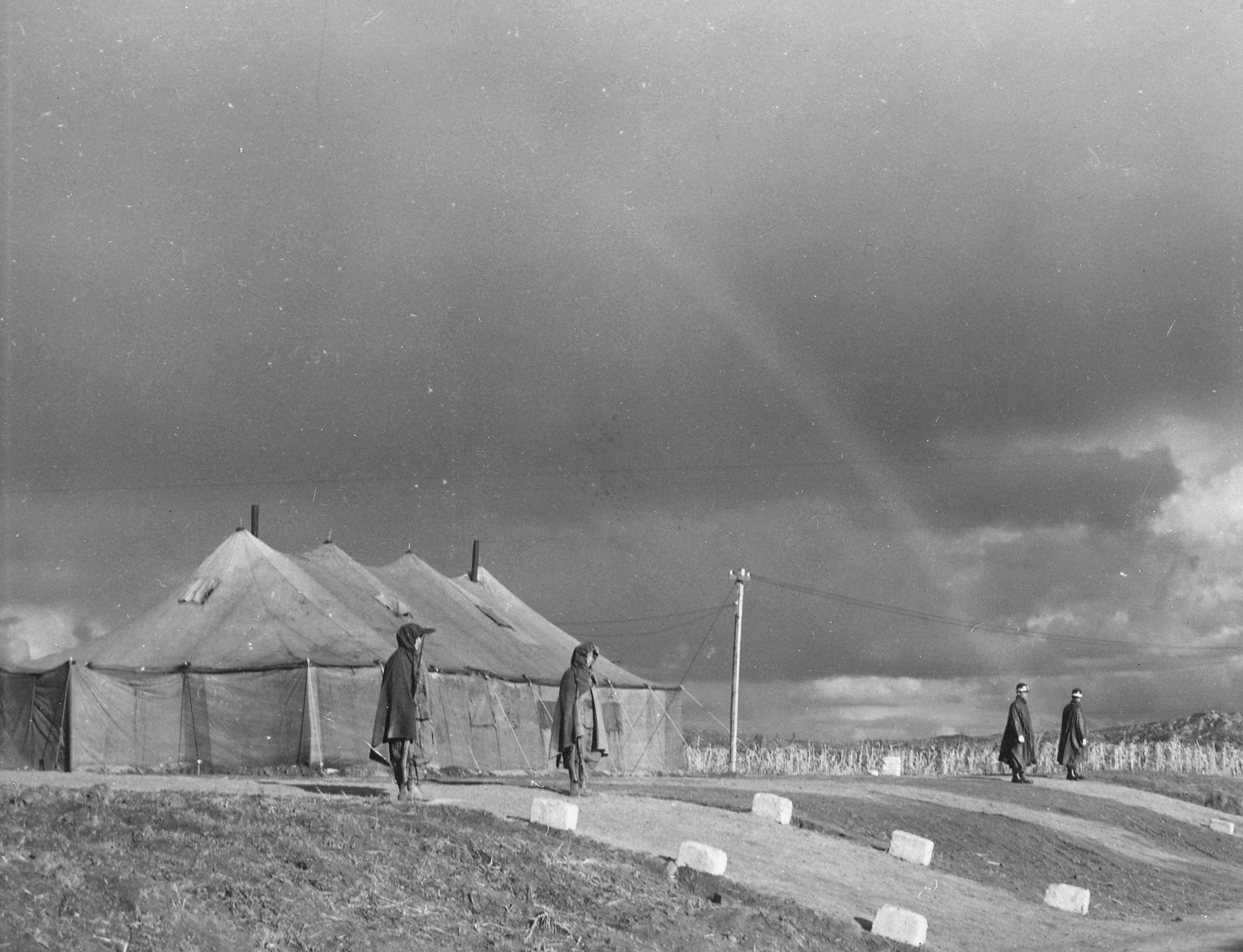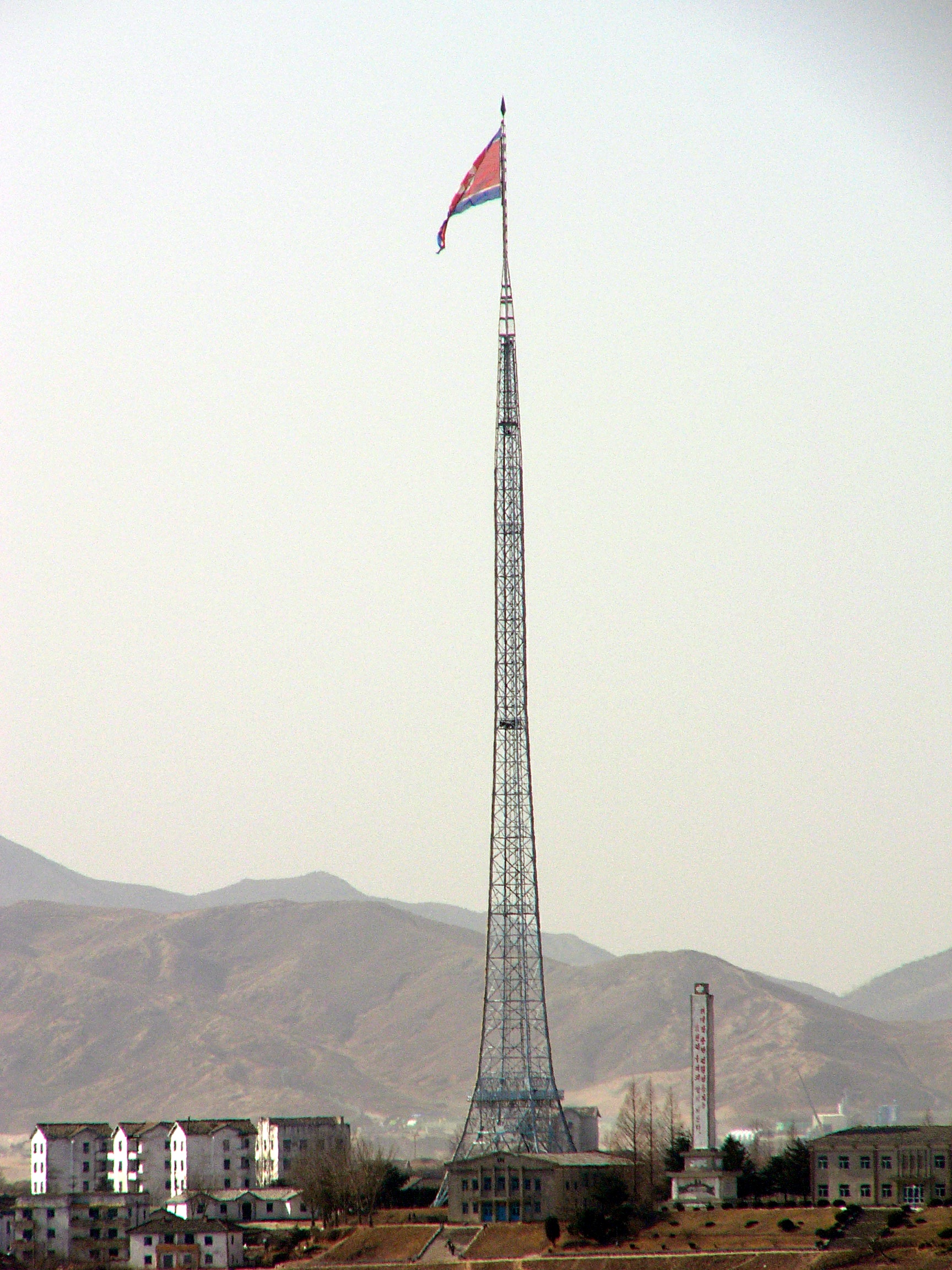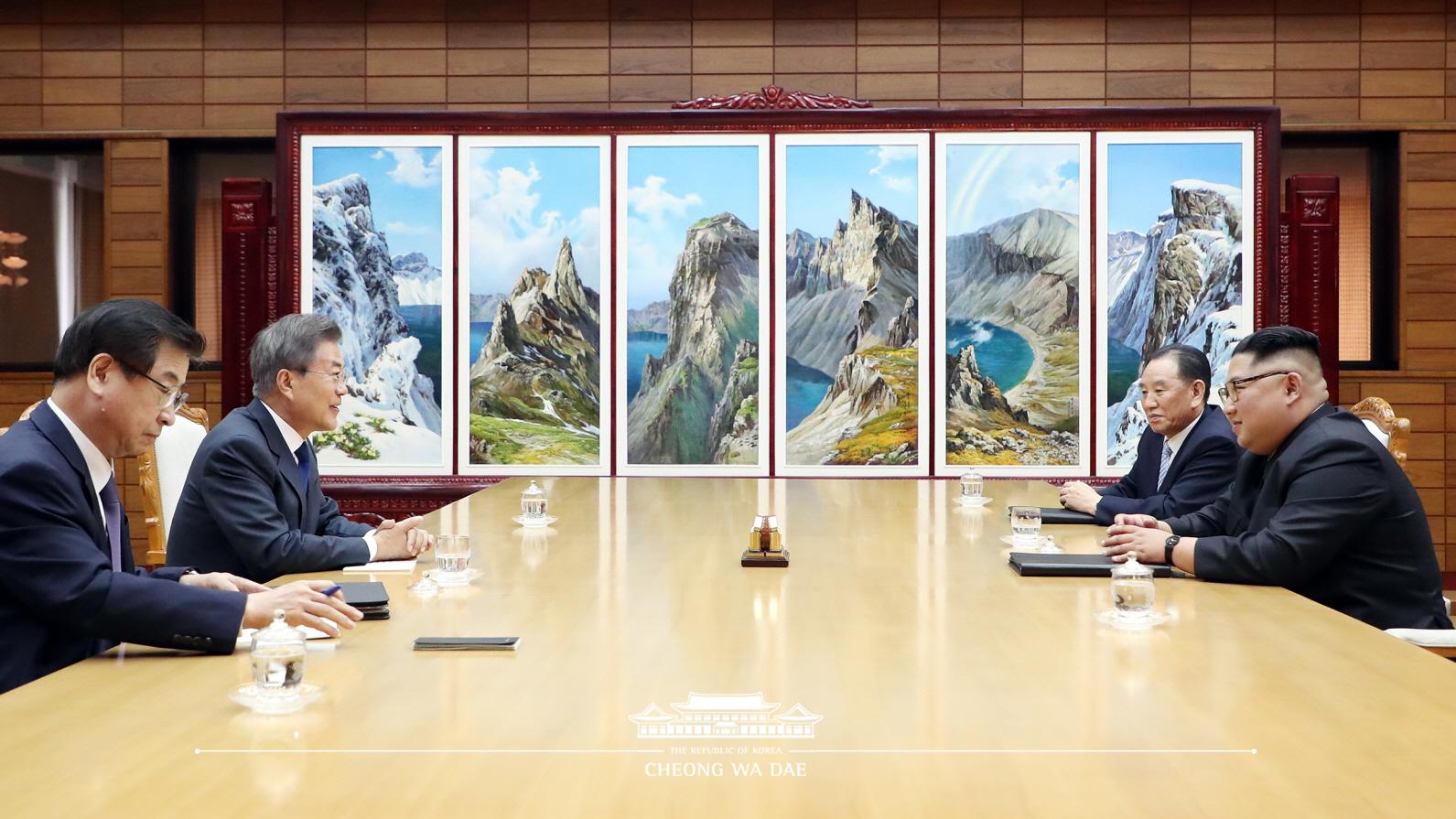|
Panmunjom
Panmunjom, also known as Panmunjeom, now located in Paju, Gyeonggi Province, South Korea or Kaesong, North Hwanghae Province, North Korea, was a village just north of the ''de facto'' border between North and South Korea, where the 1953 Korean Armistice Agreement that ended the Korean War was signed. The building where the armistice was signed still stands. Its name is often used as a metonym for the nearby Joint Security Area (JSA), where discussions between North and South Korea still take place in blue buildings that straddle the Military Demarcation Line. As such, it is considered one of the last vestiges of the Cold War. Location The site of the former village is 53 kilometers north-northwest of the capital of South Korea, Seoul and 10 kilometers east of Kaesong. The village, a small cluster of fewer than ten huts, is on the south side of the Kaesong-Seoul road on the west bank of the Sa'cheon stream. Meetings of the Military Armistice Commission took place in sever ... [...More Info...] [...Related Items...] OR: [Wikipedia] [Google] [Baidu] |
Joint Security Area
The Joint Security Area (JSA, often referred to as the Truce Village or Panmunjom) is the only portion of the Korean Demilitarized Zone (DMZ) where North and South Korean forces stand face-to-face. The JSA is used by the two Koreas for diplomatic engagements and, until March 1991, was also the site of military negotiations between North Korea and the United Nations Command (UNC). The JSA has been the site of numerous events and incidents since its establishment in 1953, the first of which was the repatriation of prisoners of war (POWs) after the cessation of hostilities, across the Bridge of No Return. In 2018, North and South Korean officials agreed to clear the JSA of all landmines, weapons and guard posts. This withdrawal was complete on October 25, 2018 and the JSA now just contains 35 unarmed security guards. It was further agreed that henceforth, the area will serve mainly as a tourist attraction. On November 6, 2018, it was announced that the UNC would transfer prim ... [...More Info...] [...Related Items...] OR: [Wikipedia] [Google] [Baidu] |
Korean Armistice Agreement
The Korean Armistice Agreement ( ko, 한국정전협정 / 조선정전협정; zh, t=韓國停戰協定 / 朝鮮停戰協定) is an armistice that brought about a complete cessation of hostilities of the Korean War. It was signed by United States Army Lieutenant General William Harrison Jr. and General Mark W. Clark representing the United Nations Command (UNC), North Korea leader Kim Il-sung and General Nam Il representing the Korean People's Army (KPA), and Peng Dehuai representing the Chinese People's Volunteer Army (PVA). The armistice was signed on 27 July 1953, and was designed to "ensure a complete cessation of hostilities and of all acts of armed force in Korea until a final peaceful settlement is achieved." During the 1954 Geneva Conference in Switzerland, Chinese Premier and foreign minister Chou En-lai suggested that a peace treaty should be implemented on the Korean peninsula. However, the US secretary of state, John Foster Dulles, did not accommodate this ... [...More Info...] [...Related Items...] OR: [Wikipedia] [Google] [Baidu] |
April 2018 Inter-Korean Summit
The April 2018 Inter-Korean summit took place on 27 April 2018 on the South Korean side of the Joint Security Area, between Moon Jae-in, President of South Korea, and Kim Jong-un, Chairman of the Workers' Party of Korea and Supreme Leader of North Korea. The summit was the third inter-Korean summit - the first in eleven years. It was also the first time since the end of the Korean War in 1953 that a North Korean leader entered the South's territory; President Moon also briefly crossed into the North's territory. The summit took place after the two sides had already held several meetings in preparation for their joint attendance at the 2018 Winter Olympics. The idea was initially brought forward through an official invitation from the North to conduct a meeting. The summit was focused on the North Korean nuclear weapons program and denuclearization of the Korean Peninsula. The Panmunjom Declaration was made following the summit. Agenda The two Koreas' high government official ... [...More Info...] [...Related Items...] OR: [Wikipedia] [Google] [Baidu] |
Korean Demilitarized Zone
The Korean Demilitarized Zone ( Korean: ; Hanbando Bimujang Jidae) is a strip of land running across the Korean Peninsula near the 38th parallel north. The demilitarized zone (DMZ) is a border barrier that divides the peninsula roughly in half. It was established to serve as a buffer zone between the countries of North Korea and South Korea under the provisions of the Korean Armistice Agreement in 1953, an agreement between North Korea, China, and the United Nations Command. The DMZ is long and about wide. There have been various incidents in and around the DMZ, with military and civilian casualties on both sides. Within the DMZ is a meeting point between the two nations, where negotiations take place: the small Joint Security Area (JSA) near the western end of the zone. Location The Korean Demilitarized Zone intersects but does not follow the 38th parallel north, which was the border before the Korean War. It crosses the parallel on an angle, with the west end of ... [...More Info...] [...Related Items...] OR: [Wikipedia] [Google] [Baidu] |
Peace House
The inter-Korean Peace House (House of Peace or Home of Peace) is a venue for peace talks between North and South Korea. The building is situated in the Joint Security Area on the south side of the Military Demarcation Line bisecting the area. Before the Korean War, the village, named Panmunjom, consisted of householders. The Peace House is a three-story structure built in December 1989 and is solely designated for non-military purposes. It is a place where peace talks are held except for the military talks between the two Koreas. It was the location of the 2018 inter-Korean summit in April 2018. * Completion date of construction: December 19, 1989 * Floor area: , 3 stories above ground * Location: The Joint Security Area (JSA) of the Korean Demilitarized Zone (DMZ) * Uses: A place for peace talks at the civilian level between North and South Korea * Jurisdiction: United Nations Command * Function: It is a venue for inter-Korean talks. * Layout: The first floor has a p ... [...More Info...] [...Related Items...] OR: [Wikipedia] [Google] [Baidu] |
North Korea
North Korea, officially the Democratic People's Republic of Korea (DPRK), is a country in East Asia. It constitutes the northern half of the Korean Peninsula and shares borders with China and Russia to the north, at the Yalu (Amnok) and Tumen rivers, and South Korea to the south at the Korean Demilitarized Zone. North Korea's border with South Korea is a disputed border as both countries claim the entirety of the Korean Peninsula. The country's western border is formed by the Yellow Sea, while its eastern border is defined by the Sea of Japan. North Korea, like its southern counterpart, claims to be the legitimate government of the entire peninsula and adjacent islands. Pyongyang is the capital and largest city. In 1910, Korea was annexed by the Empire of Japan. In 1945, after the Japanese surrender at the end of World War II, Korea was divided into two zones along the 38th parallel, with the north occupied by the Soviet Union and the south occupied by the Unit ... [...More Info...] [...Related Items...] OR: [Wikipedia] [Google] [Baidu] |
United Nations Command
United Nations Command (UNC or UN Command) is the multinational military force established to support the Republic of Korea (South Korea) during and after the Korean War. It was the first international unified command in history, and the first attempt at collective security pursuant to the Charter of the United Nations. The UNC was established on 7 July 1950 following the UN Security Council's recognition of North Korean aggression against South Korea. The motion passed because the Soviet Union, a close ally of North Korea and a member of the UN Security Council, was boycotting the UN at the time over its recognition of the Republic of China rather than the People's Republic of China. UN member states were called to provide assistance in repelling the North's invasion, with the UNC providing a cohesive command structure under which the disparate forces would operate. During the course of the war, 22 nations contributed military or medical personnel to UN Command; although the ... [...More Info...] [...Related Items...] OR: [Wikipedia] [Google] [Baidu] |
Kijŏng-dong
Kijŏng-dong, Kijŏngdong, or Kijŏng tong is a Potemkin village in P'yŏnghwa-ri (), Kaesong, North Korea. It is situated in the North's half of the Korean Demilitarized Zone (DMZ). Also known in North Korea as ''Peace Village'' (),"APK İndirelim" November 12, 2006 it has been widely referred to as 'Propaganda Village' () by those outside North Korea, especially in n and Western media. Kijŏng-dong is one of two villages permitted to remain in the wide DMZ set up under the 1953 armistice during the |
May 2018 Inter-Korean Summit
The May 2018 inter-Korean summit was the second inter-Korean summit in 2018. On 26 May, North Korean state chairman Kim Jong-un and South Korean president Moon Jae-in met again in the joint Security Area, this time on the North Korean side in the Inter-Korean Peace House in the Unification Pavilion. The meeting took two hours, and unlike other summits it had not been publicly announced beforehand. Photos released by South Korea's presidential office showed Moon arriving at the northern side of the Panmunjom truce village and shaking hands with Kim's sister, Kim Yo-jong, before sitting down with Kim for their summit. Moon was accompanied by Suh Hoon, Director of the National Intelligence Service of South Korea, while Kim was joined by Kim Yong-chol, a former military intelligence chief who is now a vice chairman of the North Korean ruling party's central committee tasked with inter-Korean relations. The meeting was largely centered around North Korean leader Kim Jong-un's u ... [...More Info...] [...Related Items...] OR: [Wikipedia] [Google] [Baidu] |
Paju
Paju () is a city in Gyeonggi Province, South Korea. Paju was made a city in 1997; it had previously been a county (''gun''). The city area of Paju is ,"Paju (Gyeonggi-do Province)." ''Naver Encyclopedia of Knowledge''. Naver, 2015. 4 Mar. 2016. and it is located just south of Panmunjeom on the 38th parallel. In 2015, the population of Paju was over 427,000. To defend the South Korean capital, Seoul, many U.S. and South Korean Army bases are set up in the area. In 2002, the northernmost South Korean railway station, Dorasan, was opened. North Korean territory and Kaesong City can be seen from Mount Dora in the city. City symbols Cosmos Cosmos is Paju City's representative of flowers growing wild in Spring. It has very strong vitality, and symbolize unity and harmonious life as a citizen of Paju City. The flowers have different colors, including pale pink and red. Gingko Ginkgos are usually planted as street trees. People can obtain high-quality wood from them. Also, their l ... [...More Info...] [...Related Items...] OR: [Wikipedia] [Google] [Baidu] |
Kaesong
Kaesong (, ) is a special city in the southern part of North Korea (formerly in North Hwanghae Province), and the capital of Korea during the Taebong kingdom and subsequent Goryeo dynasty. The city is near the Kaesong Industrial Region close to the border with South Korea and contains the remains of the Manwoldae palace. Called Songdo while it was the ancient capital of Goryeo, the city prospered as a trade centre that produced Korean ginseng. Kaesong now functions as the DPRK's light industry centre. During the Japanese occupation from 1910 to 1945, the city was known by the Japanese pronunciation of its name, "Kaijō". Between 1945 and 1950, Kaesong was part of South Korea and under its control. The 1953 Korean Armistice Agreement left the city under North Korean control. Due to the city's proximity to the border with South Korea, Kaesong has hosted cross-border economic exchanges between the two countries as well as the jointly run Kaesong Industrial Region. As of 2009, ... [...More Info...] [...Related Items...] OR: [Wikipedia] [Google] [Baidu] |
Korean War
, date = {{Ubl, 25 June 1950 – 27 July 1953 (''de facto'')({{Age in years, months, weeks and days, month1=6, day1=25, year1=1950, month2=7, day2=27, year2=1953), 25 June 1950 – present (''de jure'')({{Age in years, months, weeks and days, month1=6, day1=25, year1=1950) , place = Korean Peninsula, Yellow Sea, Sea of Japan, Korea Strait, China–North Korea border , territory = Korean Demilitarized Zone established * North Korea gains the city of Kaesong, but loses a net total of {{Convert, 1506, sqmi, km2, abbr=on, order=flip, including the city of Sokcho, to South Korea. , result = Inconclusive , combatant1 = {{Flag, First Republic of Korea, name=South Korea, 1949, size=23px , combatant1a = {{Plainlist , * {{Flagicon, United Nations, size=23px United Nations Command, United Nations{{Refn , name = nbUNforces , group = lower-alpha , On 9 July 1951 troop constituents were: US: 70.4%, ROK: 23.3% other UNC: 6.3%{{Cite ... [...More Info...] [...Related Items...] OR: [Wikipedia] [Google] [Baidu] |










